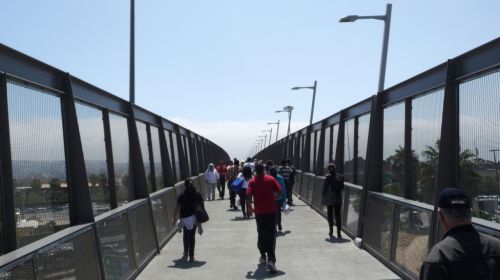ACLU Sues Over Abuse Of Photographers By Border Patrol Agents


The ACLU of San Diego filed a lawsuit today against the U.S. Customs and Border Protection agency (CBP) for violating the constitutional rights of two photographers, and for maintaining an official policy prohibiting the use of cameras and video recorders at or near U.S. crossing points, which violates the Constitution.
I spoke with David Loy of the ACLU of San Diego, who told me about his two clients in this case and what they experienced:
One of our clients is Ray Askins, an environmental activist who lives in Mexicali, Mexico—he’s an American citizen, also has a house in California. He was on the U.S. side of the border, in Calexico, standing on city street—and Calexico is a small city, the streets go literally right up to the port of entry. He was standing on the shoulder of a city street in the United States, about 50 to 100 yards from the exit to the port of entry building, taking pictures of it. He wanted to illustrate a powerpoint he was preparing to present at a conference on environmental issues; there’s substantial concern among environmentalists over pollution at the border, particularly emissions from vehicles backed up at ports of entry.
At this point a number of CBP agents emerged from the port of entry, detained him, grabbed him, threatened to smash his camera, brought him inside, handcuffed him, roughed him up, frisked him, deleted his photos, and otherwise blatantly abused his constitutional and human rights. For no valid reason that we can possibly see.
And he—as an activist, he has been in contact with border officials, and when he emailed director of Calexico Port of Entry, the director responded that the area in question is under the jurisdiction of CBP, that CBP security policies prohibit visitors at CBP-controlled facilities from using cameras without the prior approval of senior officials.
This is breathtaking—he was not inside the building, he was on a city street outside the building. They openly admit that they have a policy prohibiting him from taking pictures, and they asserted that that policy extends beyond the interior of the building itself. We dispute the validity of that policy even as it applies to the interior of that building in all circumstances. But they even asserted that it covers any photography of that building from anywhere outside the building itself.
The other plaintiff in the case is Christian Ramirez, the human rights director of Alliance San Diego, a social justice nonprofit. He’s a longtime human rights activist who works documenting human rights abuses at the border. Loy described Ramirez’s experience:
In June 2010 he crossed to Tijuana, and he was returning with his wife. After passing through the border without incident, he was crossing a pedestrian bridge over Interstate 5 on the U.S. side. As he crossed the bridge, he noticed an outbound border checkpoint—CBP has been running for the past couple of years outbound checkpoints, allegedly to stem the flow of guns and cash to Mexico. He was concerned because as he observed the checkpoint, he saw that male officers were frisking women. And so he took out his phone—he wanted to take pictures to document what he was concerned might be human rights abuses. There have been substantial concerns about human rights abuses at the border—several ACLU affiliates recently filed a complaint with DHS on abuses along the southern border.
And the same thing happened: he was on the U.S. side, he was on a public sidewalk—an area totally open to the public—and two men approached him who appeared to be private security officers, employed by CBP. They demanded his ID documents, he declined to give them, said he’d already passed through the border inspection. They ordered him to stop taking pictures, he declined. They kept going down the bridge. And then at the bottom of the bridge they were surrounded by five to seven CBP officers. They demanded to know why he’d taken any pictures, they demanded his phone, and took his phone, took his passport, scrolled through his photos, deleted photos he’d just taken. There was an officer who got very aggressive with him, saying “just give me a reason to take you down.” All for doing nothing more than the peaceful act of photographing public law enforcement conduct.
The courts have been quite clear and consistent on the fact that photography is a First Amendment right, but apparently word has not reached the Customs and Border Protection agency. And as Loy points out, that right is nowhere more strongly established than in circumstances such as those encountered by his clients:
Apart from the inherent First Amendment right to take pictures of things happening in public, there’s a particularly strong First Amendment interest in holding government accountable. And particularly, holding border agencies accountable—because there’s a record of abuse there. Among the border law enforcement agencies there’s a culture of coercion, a culture of opacity, a culture of resistance to transparency and accountability. It’s a systemic problem with law enforcement in general, but it’s especially acute along the border. CBP has grown exponentially in the last 10 years, and they routinely act as if they’re above the law. They routinely resist accountability and transparency, routinely order people to stop taking pictures. I’ve even heard stories of them ordering people to stop watching them through binoculars. It’s an outrage that any law enforcement agency, but especially a federal agency, is so resistant to having their public actions documented.
The ACLU’s complaint (online here) includes much more detailed tellings of his two client’s experiences. It alleges violations of the clients’ First Amendment rights to free speech, and Fourth Amendment rights against unlawful search and seizure and against excessive use of force.


